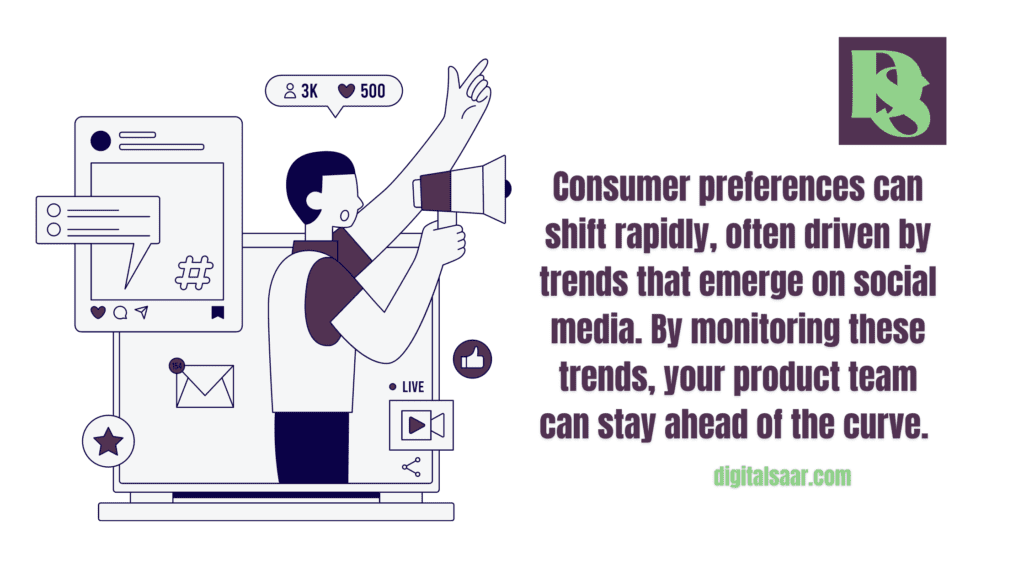How can social media monitoring inform your sales and product teams? In today’s fast-paced business world, social media isn’t just a platform for connecting with friends—it’s a powerful tool that can drive your business forward. From understanding customer sentiments to spotting industry trends, social media provides a treasure trove of insights that can transform your strategies.
Social media monitoring is the key to unlocking this potential. It involves tracking and analyzing conversations, mentions, and trends across various platforms to gain a deeper understanding of your audience and market. By keeping a finger on the pulse of social media, you can make more informed decisions, enhance your sales tactics, and fine-tune your product offerings.
What Is Social Media Monitoring?
Social media monitoring is all about keeping an ear to the ground in the digital world. At its core, it involves tracking and analyzing conversations, mentions, and trends across various social media platforms. The purpose is simple: to gather valuable insights that can help inform your business decisions. Whether it’s understanding customer feedback, spotting emerging trends, or keeping tabs on your competitors, social media monitoring provides the data you need to stay ahead.
To make the most of social media monitoring, here are some essential tools and techniques:
- Social Listening Tools: These platforms, like Hootsuite, Sprout Social, and Brandwatch, help you track mentions of your brand, competitors, and industry keywords across multiple channels.
- Sentiment Analysis: This technique analyzes the emotions behind social media posts to gauge public sentiment about your brand or products.
- Trend Analysis: Tools such as Google Trends and Trendwatching help identify emerging trends and shifts in consumer behavior.
- Competitor Analysis: Keep an eye on competitors’ activities and strategies using tools like Mention and BuzzSumo to stay competitive.
- Engagement Tracking: Monitor how users interact with your posts and campaigns to measure their effectiveness and adjust your strategies accordingly.
By using these tools and techniques, you can turn social media chatter into actionable insights that drive your sales and product development strategies.

How Can Social Media Monitoring Inform Your Sales And Product Teams?
In the digital age, social media is much more than a platform for casual interactions—it’s a critical space where businesses can gain deep insights into their customers, competitors, and market trends. But how exactly can social media monitoring inform your sales and product teams? Here’s a detailed look at how tapping into this resource can transform your strategies and drive success.
For Sales Teams
- Identifying Customer Pain Points: Social media is a space where customers often express their frustrations and challenges candidly. By monitoring these conversations, your sales team can gain a clear understanding of the most common pain points your customers face. Whether it’s a recurring issue with a product, a service that’s not meeting expectations, or a gap in the market, this information allows your team to address these concerns directly in their sales pitches. Not only does this demonstrate that you’re listening, but it also positions your product or service as the solution to these specific problems, making your sales efforts more effective and targeted.
- Tracking Competitor Activity: Keeping an eye on your competitors has always been essential, and social media makes this easier than ever. By monitoring competitor activity on social media, your sales team can gain insights into their strategies, such as promotional campaigns, customer engagement tactics, and even their customer pain points. This information is invaluable for adjusting your own sales strategies. For instance, if a competitor’s new product is receiving negative feedback, your team can highlight how your offering avoids those pitfalls. Conversely, if a competitor is doing something well, you can analyze their approach and adapt it to fit your context.
- Enhancing Lead Generation: Social media is not just a platform for existing customers; it’s also a hunting ground for new leads. By analyzing social media data, such as user behavior, interests, and engagement patterns, your sales team can identify potential leads who are likely to be interested in your products or services. These leads are often already engaged in discussions relevant to what you offer, making them more receptive to outreach. This targeted approach enhances the efficiency of your lead generation efforts, enabling your sales team to focus on high-quality prospects and increase conversion rates.
For Product Teams
- Gathering Customer Feedback: Social media is an unfiltered source of customer feedback, where users freely share their experiences with products—both good and bad. By actively monitoring these discussions, your product team can gather valuable insights into what customers love about your products and where they feel improvements are needed. This feedback is essential for making informed decisions about product enhancements, feature updates, or even the development of new products. The real-time nature of social media feedback also allows your team to be agile, quickly addressing issues or capitalizing on positive trends.
- Spotting Trends and Preferences: Consumer preferences can shift rapidly, often driven by trends that emerge on social media. By monitoring these trends, your product team can stay ahead of the curve. Whether it’s a new feature that’s gaining popularity or a design trend that’s taking off, these insights can inform your product development process. By integrating emerging trends into your products, you not only meet current customer expectations but also position your offerings as innovative and cutting-edge. This can be a significant competitive advantage in fast-moving markets.
- Managing Product Reputation: Your product’s reputation is constantly being shaped by what people say about it online. Social media monitoring allows your product team to stay on top of this conversation, whether it’s through tracking mentions, reviews, or direct feedback. If negative comments or issues arise, your team can respond quickly, addressing concerns before they escalate. This proactive approach helps to manage and protect your brand’s reputation. On the flip side, positive feedback and glowing reviews can be amplified, helping to build a stronger brand presence and increase customer loyalty.
Integrating Social Media Insights
It’s not just about gathering data—it’s about weaving those insights into the fabric of your company’s decision-making processes. Here’s how you can seamlessly integrate social media insights across your teams:
- Fostering Collaboration: Social media insights are most powerful when shared. Encourage collaboration between your sales, product, and marketing teams by creating a centralized hub for social media data. Regular cross-team meetings can help everyone stay on the same page and leverage these insights in their specific areas.
- Setting Clear Objectives: To make the most of social media monitoring, it’s crucial to have clear goals. Whether you’re aiming to boost sales, refine a product, or enhance customer engagement, define what success looks like for your team. This ensures that the insights you gather are actionable and aligned with your overall business objectives.
- Implementing Feedback Loops: Social media is a dynamic environment, so your strategies should be too. Create feedback loops where insights gathered from social media are continuously analyzed and fed back into your sales and product strategies. This ongoing process helps you stay responsive to changes in customer behavior and market trends.
- Utilizing the Right Tools: To effectively integrate social media insights, you’ll need the right tools. Invest in social listening platforms that allow for seamless data collection, analysis, and reporting. The easier it is for your teams to access and understand the data, the more effectively they can act on it.
By thoughtfully integrating social media insights, you can ensure that your teams are not just reactive but proactive, using real-time data to drive better decisions and achieve better outcomes.
Conclusion
In today’s competitive landscape, social media monitoring is more than just a nice-to-have—it’s a must-have. By harnessing the power of social media insights, your sales and product teams can make informed decisions that drive success. From identifying customer pain points to spotting trends and managing your product’s reputation, the benefits are clear.
Ready to take your strategy to the next level? Start integrating social media insights into your business processes today, and watch how it transforms your outcomes. If you found this guide helpful, don’t forget to share it with your network! And we’d love to hear your thoughts—leave a comment below with your experiences or questions on social media monitoring. Let’s keep the conversation going!
FAQs
How Can Social Media Monitoring Inform Your Sales And Product Teams?
Social media monitoring involves tracking online conversations, mentions, and trends related to your brand, competitors, industry, or keywords. It uses tools to collect and analyze data from platforms like Twitter, LinkedIn, Facebook, Reddit, and forums.
How can social media insights benefit sales teams?
Sales teams can use insights from social media to identify potential leads, understand customer pain points, tailor outreach messages, and monitor competitor activity—leading to more informed and personalized sales strategies.
In what ways can product teams leverage social media monitoring?
Product teams can discover feature requests, common complaints, emerging needs, and user feedback directly from customers. This helps in prioritizing updates, fixing bugs, and building products that better align with market demands.
Can social media monitoring help with competitor analysis?
Yes, monitoring competitor mentions and customer feedback about their products provides insights into their strengths, weaknesses, and market positioning—allowing your teams to spot opportunities and gaps in the market.
What tools are best for social media monitoring for business insights?
Popular tools include Brandwatch, Sprout Social, Hootsuite, Mention, and Talkwalker. These platforms offer real-time tracking, sentiment analysis, and reporting features that are valuable for both sales and product development teams.





